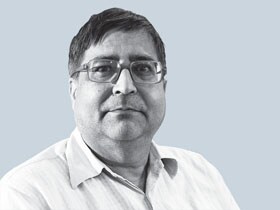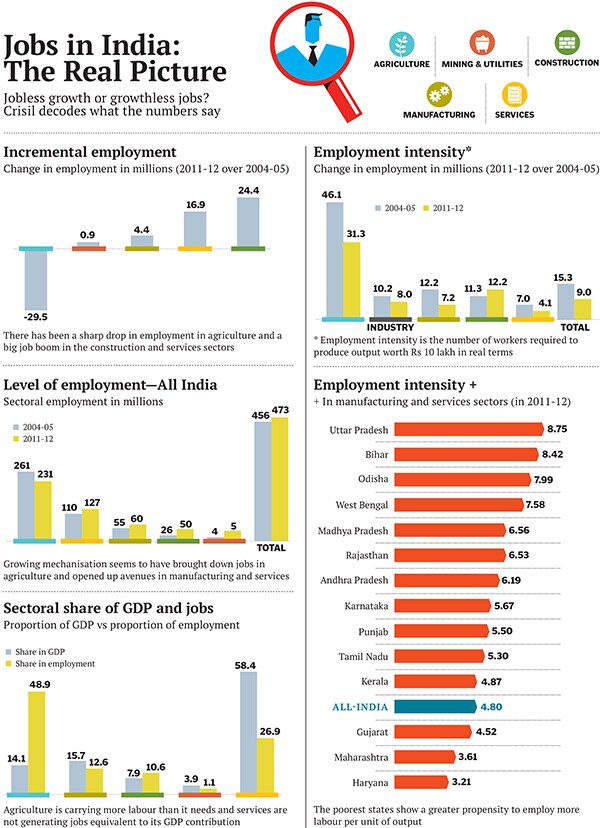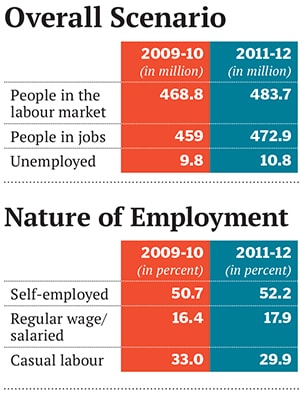India Has More Jobs, But Poorer Jobs
Jobs are growing, suggests the government's latest employment survey. But these may largely be poor quality jobs. Not something for the UPA to tom-tom after nine years


For a government buffeted on all sides by bad economic indicators and a series of scandals, pilloried for both bad policy and policy paralysis, and condemned for a series of scams of ever-increasing magnitude, any straw needs to be clutched at.
The National Sample Survey Organisation’s report on employment and unemployment in India, 2011-12, released in end-June, appeared to be one such straw for the UPA. The numbers indicated that 13.9 million more people were employed in 2011-12 than in 2009-10. If that was touted as a rebuttal of charges of jobless growth, then the decline in casual labour and the increase in salaried jobs appeared to disprove the theory about growing casualisation of labour. More women in cities were coming into the labour market and getting jobs.
There were spoilers, of course—the unemployment rate was up marginally and fewer rural women were getting employment. But at first glance, the numbers presented a slightly rosy picture. “The fact that seven million jobs a year have been created in two years when the economy wasn’t doing well isn’t trivial,” says Pronab Sen, chairman of the National Statistical Commission. Underemployment too, he notes, has come down from 6.6 percent to 5.6 percent.
But many devils lurk in the details. Several questions raised by economists and job market watchers are begging for answers. Where, for example, did the 13.9 million employment opportunities come from? It’s something that puzzles Sen too. “New jobs are created at the entry level when there are greenfield investments or expansion of existing projects by the corporate sector. Neither has happened in the past two years.” He feels that a large number of small and medium enterprises that came up during the boom years may have initially employed casual labour but later regularised them.
Most of the jobs generated, reckons Manish Sabharwal, CEO of staffing firm TeamLease, are low-wage jobs in low-productivity operations. That’s why he’s not very impressed by the data showing that the category of salaried workers has increased from 15.6 percent to 17.9 percent between 2009-10 and 2011-12 even as casual labour fell from 33.5 percent to 29.9 percent. Indeed, the draft 12th Five-Year Plan document shows 66 percent of workers are in units that employ less than six workers.
For Sabharwal, the rise in wage employment is marginal, at best. The fastest growing segment of jobs (in the organised sector), he says, is sales and customer service. “But the rise is not substantial, persistent or equal.”
There’s similar scepticism about the rise in wage employment in rural areas from 7.3 percent to 8.7 percent. A bulk of these could be low-paying jobs in the government like anganwadi workers, accredited social health activists and para-teachers, notes Alakh Sharma, director of the Institute for Human Development (IHD).
What the data also do not reveal is how the youths fared. What’s not clear, notes Sen, is how many of the 1 million additional unemployed were in that condition because there were no new jobs or they were not qualified for the new jobs. “The debate is about a job. It should be about good jobs, non-farm, formal jobs, private sector jobs,” says Sabharwal. Ajit Ghose, visiting professor at IHD, agrees, noting that India has always had employment growth of around 2 percent. “Jobless growth in the Indian context means no growth in good jobs in the formal sector.” Some number-crunching by rating agency Crisil shows some clear patterns (see charts).
Jobs are a very limiting way, however, of looking at the employment situation in India, given that self-employment and casual labour continue to account for 80 percent of employment. That is not a very good sign, since much of the self-employment is not voluntary, but distress-driven.
TS Papola, honorary professor at the Institute for Studies in Industrial Development (ISID), points to a sudden spike in self-employment in 2004-05, when agricultural growth was stagnant. Poor people cannot afford to remain unemployed and will have to take up some economic activity to make ends meet.
Perhaps one of the few positive aspects of the latest numbers is the falling share of agriculture in employment. “Farm employment needs to be brought down. It condemns people to poverty,” asserts Sabharwal.
The Tata Group’s economic advisor Siddhartha Roy notes that the growing mechanisation of farming has opened up avenues in both manufacturing and services. He points out that the use of tractors and growing demand for threshers has seen a rise in the number of drivers and mechanics in rural India. With thatched houses giving way to brick-and-mortar ones, construction is another big area of growth in the rural areas. The quality of the employment, however, will remain poor since these avenues will emerge largely in the self-employment or casual labour segments.
India’s women present a very mixed picture. After a steady decline between 1999-2000 and 2009-10, the number of urban women coming into the job market has increased by 900,000 in 2011-12. The earlier decline was attributed to women continuing with education but, says Sen, educated women were also opting out of the workforce. That tide seems to have turned.
It’s a completely contrasting picture in the case of rural women. The proportion of women in the job market fell from 26.5 percent to 25.3 percent between 2009-10 and 2010-11 and that of employed women from 26.1 percent to 24.8 percent.
There could be several reasons: One, a methodological problem, says Sen, with the productive work that women do in farms or at home not being captured in the data.
Two, social structures and attitudes. “The urban impression of work being empowering may not hold true in the rural areas, where it may be seen as a burden, an addition to domestic chores,” argues Papola.
Three, the UPA’s flagship National Rural Employment Guarantee Act (NREGA) may have played a role in keeping women away from the labour market. Why has employment increased by just 7 million a year in spite of the scheme? That is a question the UPA cannot avoid.Sure, NREGA was not meant to provide full-time employment, but a minimum number of days of work. So it really provided an additional source of employment and wages. The Planning Commission’s draft 12th Plan document notes that there has been an eight-fold rise in employment in public works after NREGA was launched. The steady fall in underemployment from 2004-05 could also be attributed to the scheme.
On the flip side, NREGA may have pulled people out of the labour market in the rural areas. Between 2004-05 and 2011-12, rural women coming into the labour force and getting jobs dipped 18 percent, while the figure for men grew only 7 percent in both cases. The draft 12th Plan document also attributes this to NREGA.
That this has been much more pronounced in the case of women is borne out in an analysis by Akhilesh Tilotia of Kotak Institutional Equities, which notes that the share of women in NREGA employment increased from 40 percent in 2007 to 48 percent in 2012.
Clearly the initial job data put out hide more than they reveal.
WHAT THE EXPERT SAY  PRONAB SEN
PRONAB SEN
Chairman, National Statistical Commission
We have created 7 million jobs a year at the entry level. The average GDP growth during this period was around 5.8%. But we are adding half a million less jobs to absorb those coming into the labour force. Underemployment has come down by 1 percentage point. Over a decade-and-a-half, unemployment by current daily status (unemployment plus underemployment) has dipped from 10% to 5.5%. This shows that those underemployed are more employed and may have higher incomes.
 MANISH SABHARWAL
MANISH SABHARWAL
CEO, TeamLease
The fundamental story is that the labour market transformation hasn’t happened. Things are where they were in 1991 or even 10 years ago. Which jobs are being created, at what wage is the key question. In the current trajectory, 100% of net job creation is in the informal sector, making India a statistical outlier globally. What is not passing the smell test is the unemployment data. They need to redefine what unemployment is. I would add the working poor to the unemployed.

TCA ANANT
Chief Statistician
The word ‘job’ has the connotation of regular work. Most of our employment is not in that form. In the self-employment sector, a substantial amount of employment is of a residual character. The rise of wage employment, reduction in self employment and decrease in unpaid work are very positive indications.
A concern area continues to be the low participation of women. This is a reflection of social structures and lack of institutional support for working women.
 Dressing Up The Numbers?
Dressing Up The Numbers?
What made the NSSO conduct the 2011-12 employment survey just two years after the earlier one in 2009-10 instead of the normal five years? “Two years is too small a timeframe to capture major changes in the economy and job market,” says Siddhartha Roy, chief economist, Tata Services.
Data from the large NSSO surveys is used in the national accounts for changing the base year of the GDP series. There was, however, a problem in using the 2009-10 survey as the base, since it was the year of the recession and a terrible drought. “The basic rule is to never use an abnormal year as base,” explains Pronab Sen, chairman of the National Statistical Commission and the chief statistician of India in 2009. “That gives a misleading impression of economic activity and growth,” seconds TCA Anant, who succeeded Sen as chief statistician.
A base change, however, couldn’t have waited till the next large round in 2014-15. Since the schedule allowed for another large survey, it decided to do one in 2011-12.
That hasn’t quelled conspiracy theories that the survey was conducted and results released to burnish the government’s image. But Anant laughs it off. The first results of the 2009-10 survey were available only from July 2011. By then, not only had the decision to conduct a survey in 2011-12 been taken but the preparatory work for it was complete.
Five-year surveys of employment are also problematic. The 2004-05 survey too, says TS Papola of ISID, threw up unusual results—spurts in people entering the labour force and getting work, especially as self-employed, unlike the normal trend—because that was a year of agricultural growth of just 1%. Anant admits quinquennial surveys can also be misleading. “There are so many idiosyncratic characteristics of a particular year that we are comparing pictures that are very far apart and then trying to get a sense of an underlying trend.”
What would help will be getting more regular employment data in the West, it is available on a yearly basis.
But India’s labour market, with high levels of self-employment and informal sector work, is complex.
“These make labour force assessment in India a very challenging task,” says Anant.
First Published: Jul 23, 2013, 06:39
Subscribe Now
